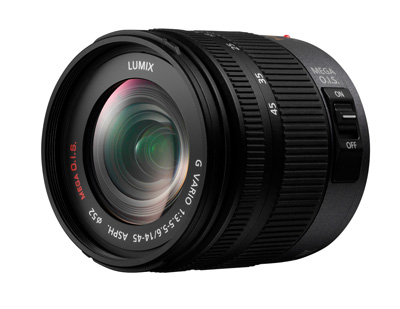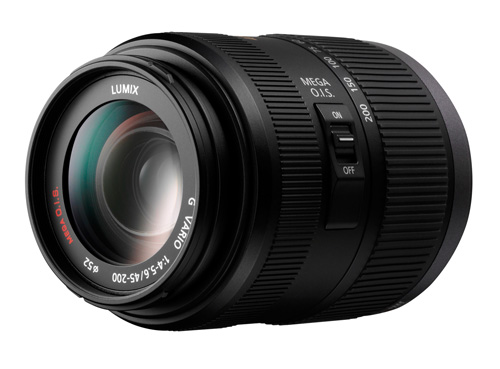Panasonic G1: Smallest and Lightest Interchangeable Lens Digital Camera
by Wesley Fink on September 15, 2008 1:00 PM EST- Posted in
- Digital Camera
Micro Four Thirds Lenses Press Release
PANASONIC INTRODUCES WORLD'S FIRST INTERCHANGEABLE LENSES FOR MICRO FOUR THIRDS SYSTEM DIGITAL CAMERAS
Two New Lenses Compatible with LUMIX G1, the World's Smallest & Lightest Interchangeable Lens Digital Camera, Part of the Micro Four Thirds System
SECAUCUS, NJ - Panasonic announces the world's first interchangeable lenses designed for the new Micro Four Thirds System. The LUMIX G VARIO 14-45mm/F3.5-5.6 ASPH/MEGA O.I.S will be the standard kit lens with the LUMIX DMC-G1, the world's first Micro Four Thirds System digital camera, which also debuted today. In addition, the LUMIX G VARIO 45-200mm/F4.0-5.6/MEGA O.I.S. telephoto lens, also designed for the Micro Four Thirds format, offers an enhanced zoom range for use with the DMC-G1 and other cameras based on the new standard.

Panasonic's two new Micro Four Thirds System lenses produce professional-level images, typical of digital single-reflex lens (DSLR) cameras, while greatly reducing the size. For instance, the LUMIX G VARIO 14-45mm/F3.5-5.6 ASPH./MEGA O.I.S lens is nearly half the size and weight of traditional DSLR lenses with comparable focal lengths. Both lenses feature Panasonic's Mega O.I.S. (optical image stabilizer), which helps reduce blur caused by hand movement when snapping photos, and are compatible with Panasonic's Contrast AF (Auto Focus) system found in the LUMIX DMC-G1. Contrast AF in the G1 allows the user to choose from a wide-range of AF modes, including: multiple-area AF with up to 23 focus areas; 1-area AF with a selectable focus area; Face Detection; and AF Tracking. The lenses also feature a durable metal mount and multi-coated lens to reduce ghosts and flares on images. In addition, seven aperture blades create a rounded shape that produces smoothness when shooting out-of-focus areas, helping to deliver top optical performance.

"The introduction of the Micro Four Thirds System is a huge advancement for digital photographers as the reduction in size and weight of these lenses will really change the market and make this format more approachable," said David Briganti, National Marketing Manager, Imaging, Panasonic Consumer Electronics Company. "Average consumers interested in purchasing an advanced camera were previously deterred by the bulkiness and inconvenience of DSLRs, so these new lenses provide the same level of quality that consumers demand, but in a package much more suitable for active lifestyles."
The LUMIX G VARIO 14-45mm/F3.5-5.6ASPH./MEGA O.I.S. will be part of the kit with the LUMIX DMC-G1 body and will be available in mid-November. The LUMIX G VARIO 45-200mm/F4.0-5.6/MEGA O.I.S. will also be available in November. Pricing for the both lenses will be announced in early October.










20 Comments
View All Comments
aeternitas - Monday, September 15, 2008 - link
I agree. Thats something they should use as a selling point more than anything else about the camera.aeternitas - Monday, September 15, 2008 - link
Them going on and on about how 'smooth' and 'accurate' ect ect this thing is and not mentioning the actual size of the CCD makes me roll my eyes.It’s pretty obvious to me this is a stunt to create some new type of camera sector. Compact SLR? Give me a break. That doesn’t even make any sense! By definition you’re going to have a lens, even if prime, that’s not going to fit comfortably in your pocket! Not only that, but if the camera itself is too light the lens will make it unbalanced on a tripod and in hand. I hope they were at LEAST smart enough to put the tripod threading further up closer to the lens itself under the camera, but that doesn’t change the in-hand issue.
If you think it’s a non-issue then you’re better off with a PoS camera, because SLRs are made to be comfortable through 1000s of images taken in a days’ time. Your hands will start to hurt, and isn’t that kind of contradictory to the purpose of this camera? Comfort? Or is there another purpose? I don’t really understand the point of this.
Let’s not forget the most important thing; Even the best consumer SLRS with full frame CCDs and superb SnR cannot resolve the resolution of the glass in front of them. What is the POINT of putting glass that even those cameras cannot resolve in front of this? It’s like putting 8GB of ram into a system that can only see 3.5.
Unless this thing is like 300$, it’s sort of an insult to any photographer with half a wit.
aeternitas - Monday, September 15, 2008 - link
I’d like to correct that the CCD was mentioned, skipped a page. My mistake. My point is made clearer though, as the pixel density is 5.Wesley Fink - Monday, September 15, 2008 - link
Yes, the pixel density is 4.98 MP/centimeter square as we pointed out, but the New Canon 50D is 4.5 which is not a hyge difference. You missed the point that the P&S densities are 28 to 36 MP per square centimeter which are a huge density difference compared to 4/3.In fact all of the APS-C sensors are all but the same when you look at the huge density advantage they hold over the best of today's point-and shoot models. Frankly people need to get past the emotion over the 4/3 sensor size and look at the facts, which are nowhere near the stark picture some like to paint. The 4/3 sensor is 75% the area of the the Canon sensor, and 6 to 8 times larger than the best P&S sensors.
Ajax9000 - Monday, September 15, 2008 - link
"Frankly people need to get past the emotion over the 4/3 sensor size ..."Agreed.
The smaller sensor in FT is claimed to be the equvilant of about 0.5-1 stop slower than the larger sensors in "conventional" dSLRs, but as can be seen with the Zuiko ED 12-60mm, the FT mount can enable faster lenses for a given size -- i.e. negating the supposed disadvantage. Lenses for mFT should be the same or better.
[quote]
Olympus ... have taken advantage of the Four Thirds sensor to deliver lenses which, for any given size, weight and cost, simply perform to a higher and more consistent standard than those optimized for larger formats ... The relatively fast maximum aperture (a half to a full stop faster than APS-C equivalents ...), coupled with the excellent wide-open performance, also allows the use of lower ISOs at equivalent light levels for maximum image quality.
[/quote]
From http://www.dpreview.com/lensreviews/olympus_12-60_...">http://www.dpreview.com/lensreviews/olympus_12-60_...
aeternitas - Monday, September 15, 2008 - link
The beef I have with this type of deal is there is no point. Honestly what’s the point? You can’t fit this anywhere a normal DSLR couldn’t go. It’s a diluted mix of SLR and point and shoots taking the worst qualities from each. Too big to be put anywhere advantageous over a normal DSLR and worse than even some of the worst pixel densities in the DSLR market.When you say it’s nowhere near the bad picture some people paint, you put yourself in a category of 'good enough'. People that spend 1000$ on glass and camera equipment do not do 'good enough' they do not want gimmicks. This is such a gimmick camera. The only interesting feature with practical use is that the glass is closer to the CCD.
Like I said, they can word things in a way to make the practical aspects of teh camera that are bad, sound good, but in the end they need to stop it and focus on the true pluses of this design.
strikeback03 - Monday, September 15, 2008 - link
The G1 at least is very similar in dimensions to the superzoom-class P&S cameras, and body-only similar in size to something like the Canon G9. So while this should take a big bite out of the superzoom market (at least once the micro 4/3 14-140 lens drops), I don't really consider it "pocketable". We have a couple of Canon S5IS cameras here in the lab, with the exception of large cargo pockets or maybe a pullover hoodie I don't have any pockets which could hold something that size comfortably. So if I am bringing some sort of camera bag anyway I don't see the problem with stepping up to the smaller traditional DSLRs from Olympus, Canon, Pentax, etc. But it will give Panasonic something different in the marketplace.tdawg - Monday, September 15, 2008 - link
Being so small, yet packing potentially high level image quality, would be nice for hiking and camping where one doesn't want to haul a more traditially-sized SLR and lenses, I would think. Also potentially nice for people that like to sneak camera gear into concerts and such. :)Personally, I don't like non-optical viewfinders on my SLRs, but as long as it has a viewfinder in addition to the rear LCD, it might not be too bad. The problem is that I can't see myself investing any money in any system other than my current Nikon system, so...
aeternitas - Monday, September 15, 2008 - link
"Haul"? Are you serious? This thing maybe weighs 2-300GRAMS less than a proper DSLR. If you can't handle 300grams to take obviously better photography you might as well use your cameraphone with that line of thought.expiringfrog - Wednesday, September 24, 2008 - link
I'm not sure how you conclude that a DSLR will take "obviously better photography (sic)". The G1 sensor is the same size as those used in all of Olympus' range of "proper DSLR's". Wesley points out quite correctly that this is not much smaller than 35mm full-frame and has perfectly decent imaging characteristics, certainly far better than the fingernail-sized sensors used in typical compact cameras. So this is certainly comparable to a "proper DSLR" in image quality. As for handling and speed, it all depends on what type of pictures you want to take: this isn't something you'd normally use to shoot motorsports, but on a hike it's as good as any DSLR, and will only get better as technology progresses.As for the weight difference of 300 grams, you've never met a serious hiker, have you?